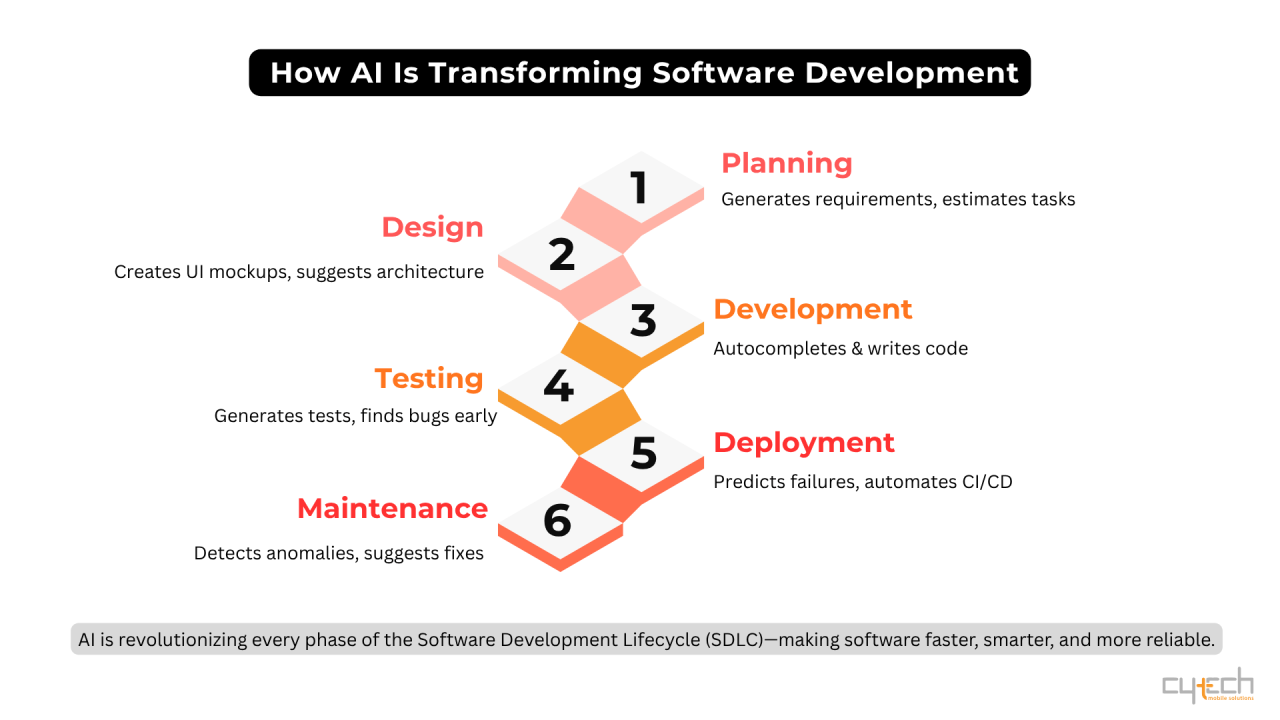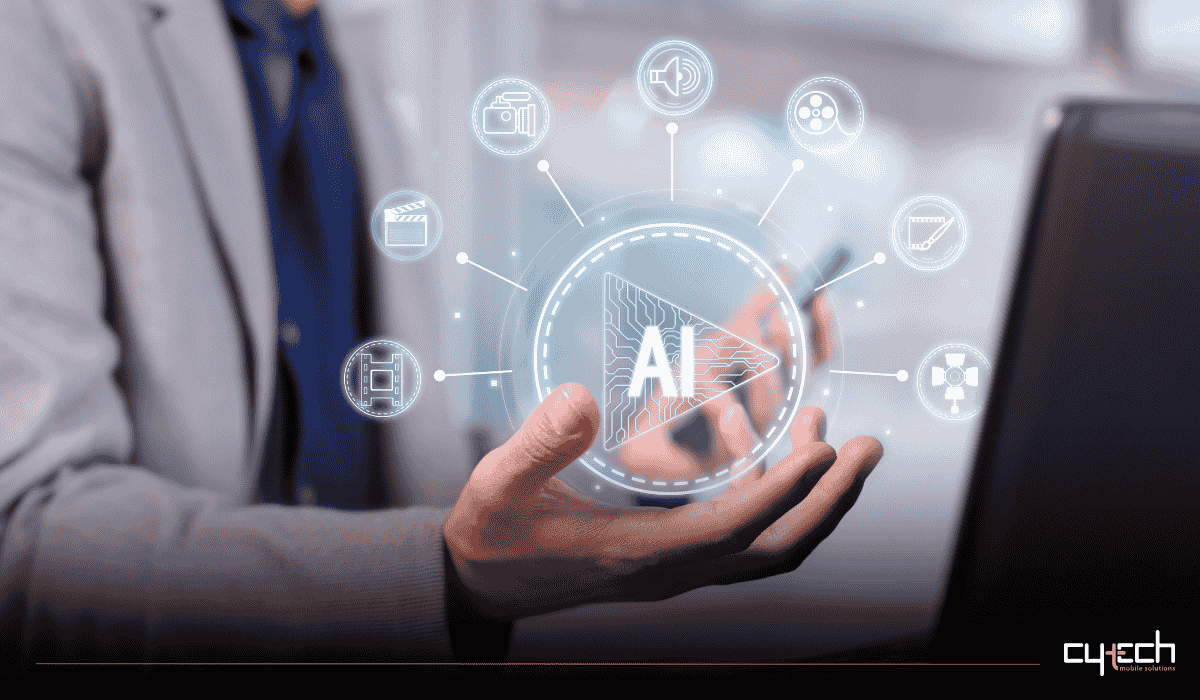Table of Contents
In this article, we’ll explore how Artificial Intelligence is changing each phase of the SDLC, identify key benefits, tools, and challenges, and consider the future of AI-augmented development.
AI Integration Across the SDLC
Artificial Intelligence is no longer just a support feature—it’s a fundamental component of modern software workflows. Below is an overview of how Artificial Intelligence is embedded in each SDLC phase and the benefits it provides:
| SDLC Phase | AI Capabilities | Key Benefits |
|---|---|---|
| Planning | Data analysis, requirement drafting, effort estimation | Quicker project kickoff, more informed decisions |
| Design | UI/UX prototyping, architectural suggestions | Faster prototyping, consistent interfaces |
| Development | Code generation, natural language to code, real-time suggestions | Increased speed, fewer errors |
| Testing | Automated unit tests, fault prediction, adaptive coverage | Early bug detection, improved reliability |
| Deployment | CI/CD optimization, failure prediction, auto-rollbacks | Smoother releases, reduced downtime |
| Maintenance | Anomaly detection, automated patches, performance monitoring | Continuous uptime, proactive enhancements |
Planning and Requirements Gathering
Artificial Intelligence has significantly shortened the planning cycle. By analyzing user feedback, historical project data, and market needs, Artificial Intelligence can generate detailed product requirements, suggest user stories, and provide estimates with higher confidence levels (source). AI-driven planning tools enable faster initiation of projects by identifying goals, predicting development complexity, and highlighting risks based on data—not guesswork. This turns planning from a laborious exercise into an efficient, insights-driven process.
Design and Architecture
In the design stage, AI helps streamline architectural decision-making and UI design. Tools powered by generative Artificial Intelligence can take simple inputs—such as descriptions or wireframes—and create high-fidelity designs, suggest layout optimizations, or improve accessibility compliance (source). By learning from thousands of UX patterns and successful interfaces, Artificial Intelligence accelerates design iterations while promoting consistency across platforms.
Development and Code Generation
Coding is one of the most visibly transformed phases. Tools like GitHub Copilot, Amazon CodeWhisperer, and Tabnine assist developers by offering intelligent code completions, turning comments into functions, and refactoring code for clarity and performance (source).
GitHub’s study on Copilot found that developers using the tool completed tasks 55% faster than those without AI assistance (source). These assistants reduce repetitive workload and improve development flow, allowing engineers to focus on logic and architecture rather than boilerplate code. As models improve, they will increasingly offer personalized code recommendations tailored to the team’s style and structure.
Testing and Quality Assurance
Artificial Intelligence has redefined quality assurance. Instead of manually writing hundreds of tests, Artificial Intelligence tools like Diffblue Cover for Java generate unit tests based on code behavior. Adaptive testing frameworks can prioritize what to test based on recent code changes, while Artificial Intelligence models can analyze logs and source history to predict fault-prone areas.
The result is broader test coverage, earlier bug detection, and automated regression testing. By continuously analyzing patterns, AI-powered QA tools also suggest missing edge cases or flag inconsistent logic, making the testing process more robust and efficient.
Deployment and DevOps Automation
In CI/CD pipelines, Artificial Intelligence enables proactive release management. It monitors build health, predicts failure rates, optimizes build sequences, and automatically scales environments depending on the project needs. Platforms like CircleCI leverage AI agents—such as “Chunk”—to fix build failures on the fly, analyze dependencies, and adapt workflows accordingly.
This creates a feedback loop that ensures safe, stable deployments without extensive human oversight. Artificial Intelligence also helps in rollback procedures by tracking application behavior and performing real-time evaluations during canary or blue/green releases.
Maintenance and AIOps
Artificial Intelligence doesn’t stop working after software is released. It plays a key role in monitoring and maintenance through AIOps—AI for IT operations. AIOps systems analyze logs, metrics, and event data to detect anomalies, forecast incidents, and suggest remediation actions. If, for example, a spike in memory usage is detected, an AI tool might flag the root cause or propose a temporary fix, long before users report any issues.
Furthermore, AI agents feed user behavior and telemetry back into the product roadmap, helping prioritize enhancements. This transforms maintenance from a reactive to a proactive process and shortens the time between identification and resolution of issues.
Benefits of AI in the SDLC
The end-to-end integration of AI in software development provides measurable benefits. Development becomes faster thanks to AI-driven planning, generation, and testing. Code quality improves as Artificial Intelligence flags vulnerabilities and logic errors early. Developer experience is enhanced as cognitive load decreases, and teams can focus on innovation rather than routine work. Perhaps most importantly, AI introduces real-time feedback mechanisms into each phase, promoting continuous learning and improvement.
According to McKinsey, companies that embrace AI for product development can speed up release cycles by over 25%, while reducing testing and QA costs significantly (source).
Leading Tools Reshaping Development
- GitHub Copilot: Built on OpenAI’s Codex, Copilot offers real-time code suggestions and full-function completions in IDEs like VS Code.
- Amazon CodeWhisperer: Completes code and scans for security vulnerabilities, offering licensing context for generated code.
- Tabnine: Trained only on permissively licensed code, it can be deployed privately and customized for enterprise projects.
- Diffblue Cover: Specializes in generating unit tests for Java, helping maintain code quality at scale.
- CircleCI + Chunk AI: Monitors and optimizes CI/CD pipelines with self-healing capabilities.
Risks and Ethical Considerations
Despite the advantages, integrating Artificial Intelligence into the SDLC introduces challenges. Code generated by AI may reflect biases or bad practices present in its training data. Some tools have been shown to suggest insecure code or to reinforce biased logic patterns . Intellectual property concerns also arise—if an Artificial Intelligence tool is trained on copyrighted code, is the output original or derivative?
Furthermore, there’s the human factor: over-reliance on AI tools may reduce critical thinking and core programming skills. Developers must still validate AI-generated output, understand how it works, and ensure that it aligns with project requirements and security standards.
To mitigate these risks, organizations must establish governance policies, require manual code reviews, and educate teams on ethical Artificial Intelligence use. Transparency, traceability, and continuous monitoring of Artificial Intelligence tools are essential for maintaining control over software quality and compliance.

The Road Ahead
The future of software development is clearly intertwined with AI. Stack Overflow’s 2025 Developer Survey reports that over 84% of developers are already using or planning to use AI tools regularly (source). As language models evolve, Artificial Intelligence will become even more capable—moving from code completion to full application generation, based on conversational inputs.
What’s next? Expect Artificial Intelligence to become natively embedded in IDEs, deployment pipelines, and monitoring platforms. Developers will increasingly act as system orchestrators, guiding Artificial Intelligence tools and reviewing output rather than manually building every component. Development teams that harness Artificial Intelligence responsibly will benefit from faster delivery, lower costs, and more robust products.
In conclusion, AI is not replacing developers—it’s empowering them. The software engineering process is becoming more iterative, intelligent, and resilient. Those who embrace this transformation will shape the next era of innovation.

